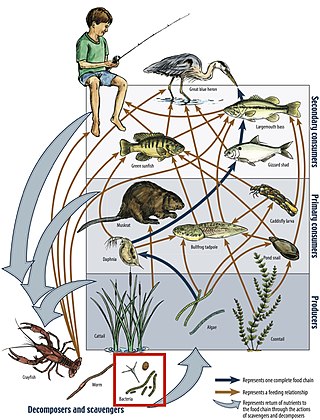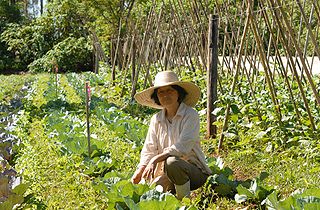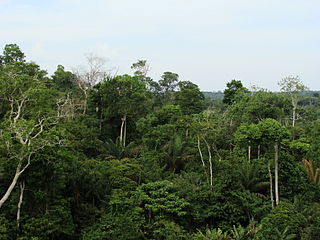Soil fauna
Soil fauna is crucial to soil formation, litter decomposition, nutrient cycling, biotic regulation, and for promoting plant growth. Yet soil organisms remain underrepresented in studies on soil processes and in existing modeling exercises. This is a consequence of assuming that much below ground diversity is ecologically redundant and that soil food webs exhibit a higher degree of omnivory. However, evidence is accumulating on the strong influence of abiotic filters, such as temperature, moisture and soil pH, as well as soil habitat characteristics in controlling their spatial and temporal patterns. [2]
Soils are complex systems and their complexity resides in their heterogeneous nature: a mixture of air, water, minerals, organic compounds, and living organisms. The spatial variation, both horizontal and vertical, of all these constituents is related to soil forming agents varying from micro to macro scales. [3] Consequently, the horizontal patchy distribution of soil properties (soil temperature, moisture, pH, litter/nutrient availability, etc.) also drives the patchiness of the soil organisms across the landscape, [4] and has been one of the main arguments for explaining the great diversity observed in soil communities. [5] Because soils also show vertical stratification of their elemental constituents along the soil profile as result of microclimate, soil texture, and resource quantity and quality differing between soil horizons, soil communities also change in abundance and structure with soil depth. [6] [2]
The majority of these organisms are aerobic, so the amount of porous space, pore-size distribution, surface area, and oxygen levels are crucial to their life cycles and activities. The smallest creatures (microbes) use the micropores filled with air to grow, whereas other bigger animals require bigger spaces, macropores, or the water film surrounding the soil particles to move in search for food. Therefore, soil textural properties together with the depth of the water table are also important factors regulating their diversity, population sizes, and their vertical stratification. Ultimately, the structure of the soil communities strongly depends not only on the natural soil forming factors but also on human activities (agriculture, forestry, urbanization) and determines the shape of landscapes in terms of healthy or contaminated, pristine or degraded soils. [2]
Macrofauna

Soil invertebrates are shown. Ellipses indicate hot (red) or cold spots (blue), with the curved arrows giving some examples of the factors that could switch on/off a hot moment and the straight black arrows (continuous black line = on, dashed = off) showing the implications for soil processes along the soil profile. In the boxes, the main ecosystem characteristics are listed.
Since all these drivers of biodiversity changes also operate above ground, it is expected that there must be some concordance of mechanisms regulating the spatial patterns and structure of both above and below ground communities. In support of this, a small-scale field study revealed that the relationships between environmental heterogeneity and species richness might be a general property of ecological communities. [5] In contrast, the molecular examination of 17,516 environmental 18S rRNA gene sequences representing 20 phyla of soil animals covering a range of biomes and latitudes around the world indicated otherwise, and the main conclusion from this study was that below-ground animal diversity may be inversely related to above-ground biodiversity. [7] [2]
The lack of distinct latitudinal gradients in soil biodiversity contrasts with those clear global patterns observed for plants above ground and has led to the assumption that they are indeed controlled by different factors. [8] For example, in 2007 Lozupone and Knight found salinity was the major environmental determinant of bacterial diversity composition across the globe, rather than extremes of temperature, pH, or other physical and chemical factors. [9] In another global scale study in 2014, Tedersoo et al. concluded fungal richness is causally unrelated to plant diversity and is better explained by climatic factors, followed by edaphic and spatial patterns. [10] Global patterns of the distribution of macroscopic organisms are far poorer documented. However, the little evidence available appears to indicate that, at large scales, soil metazoans respond to altitudinal, latitudinal or area gradients in the same way as those described for above-ground organisms. [11] In contrast, at local scales, the high diversity of microhabitats commonly found in soils provides the required niche portioning to create “hot spots” of diversity in just a gram of soil. [8] [2]
Not only spatial patterns of soil biodiversity are difficult to explain, but also its potential linkages to many soil processes and the overall ecosystem functioning remains under debate. For example, while some studies have found that reductions in the abundance and presence of soil organisms results in the decline of multiple ecosystem functions, [12] others concluded that above-ground plant diversity alone is a better predictor of ecosystem multi-functionality than soil biodiversity. [13] Soil organisms exhibit a wide array of feeding preferences, life-cycles and survival strategies and they interact within complex food webs. [14] Consequently, species richness per se has very little influence on soil processes and functional dissimilarity can have stronger impacts on ecosystem functioning. [15] Therefore, besides the difficulties in linking above and below ground diversities at different spatial scales, gaining a better understanding of the biotic effects on ecosystem processes might require incorporating a great number of components together with several multi-trophic levels [16] as well as the much less considered non-trophic interactions such as phoresy, passive consumption. [17] ) In addition, if soil systems are indeed self-organized, and soil organisms concentrate their activities within a selected set of discrete scales with some form of overall coordination, [18] there is no need for looking for external factors controlling the assemblages of soil constituents. Instead we might just need to recognize the unexpected and that the linkages between above and below ground diversity and soil processes are difficult to predict. [2]
Microfauna
Recent advances are emerging from studying sub-organism level responses using environmental DNA [19] and various omics approaches, such as metagenomics, metatranscriptomics, proteomics and proteogenomics, are rapidly advancing, at least for the microbial world. [20] Metaphenomics has been proposed recently as a better way to encompass the omics and the environmental constraints. [21] [2]

















